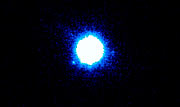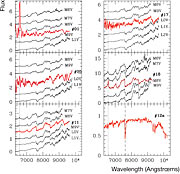Press Release
Do 'Planemos' Have Progeny?
Planetary-Mass Objects Found to be Surrounded by Discs
6 June 2006
Two new studies, based on observations made with ESO's telescopes, show that objects only a few times more massive than Jupiter are born with discs of dust and gas, the raw material for planet making. This suggests that miniature versions of the solar system may circle objects that are some 100 times less massive than our Sun.
These findings are to be presented Monday, 5 June at the American Astronomical Society meeting in Calgary, Canada.
Since a few years, it is known that many young brown dwarfs, 'failed stars' that weigh less than 8 percent the mass of the Sun, are surrounded by a disc of material. This may indicate these objects form the same way as did our Sun.
The new findings confirm that the same appears to be true for their even punier cousins, sometimes called planetary mass objects or 'planemos'. These objects have masses similar to those of extra-solar planets, but they are not in orbit around stars - instead, they float freely through space.
"Our findings, combined with previous work, suggest similar infancies for our Sun and objects that are some hundred times less massive", says Valentin D. Ivanov (ESO), co-author of the first study.
"Now that we know of these planetary mass objects with their own little infant planetary systems, the definition of the word 'planet' has blurred even more," adds Ray Jayawardhana, from the University of Toronto (Canada) and lead author of the study. "In a way, the new discoveries are not too surprising - after all, Jupiter must have been born with its own disc, out of which its bigger moons formed."
Unlike Jupiter, however, these planemos are not circling stars. In their study, Jayawardhana and Ivanov used two of ESO's telescopes - Antu, the 8.2-metre Unit Telescope no. 1 of the Very Large Telescope, and the 3.5-metre New Technology Telescope - to obtain optical spectra of six candidates identified recently by researchers at the University of Texas at Austin. Two of the six turned out to have masses between five to 10 times that of Jupiter while two others are a tad heftier, at 10 to 15 times Jupiter's mass. All four of these objects are 'newborns', just a few million years old, and are located in star-forming regions about 450 light-years from Earth. The planemos show infrared emission from dusty discs that may evolve into miniature planetary systems over time.
In another study, Subhanjoy Mohanty (Harvard-Smithsonian Center for Astrophysics, CfA), Ray Jayawardhana (Univ. of Toronto), Nuria Huelamo (ESO) and Eric Mamajek (also at CfA) used the Very Large Telescope, this time with its adaptive optics system and infrared camera NACO, to obtain images and spectra of a planetary mass companion discovered at ESO two years ago around a young brown dwarf that is itself about 25 times the mass of Jupiter. This planetary mass companion is the first-ever exoplanet to have been imaged (see ESO Press Release eso0515).
The brown dwarf, dubbed 2M1207 for short and located 170 light-years from Earth, was known to be surrounded by a disc. Now, this team has found evidence for a disc around the eight-Jupiter-mass companion as well.
"The pair probably formed together, like a petite stellar binary", explains lead author Mohanty, "instead of the companion forming in the disc around the brown dwarf, like a star-planet system."
"Moreover", Jayawardhana adds, "it is quite likely that smaller planets or asteroids could now form in the disc around each one."
More information
Recent developments on exoplanets at ESO
The recent discovery is the latest achievement in a long series of breakthroughs made with ESO's telescopes. The ESO La Silla Paranal Observatory, with its armada of instruments equipping the four 8.2-m telescopes composing the Very Large Telescope and the various telescopes in the 1.5-m to 3.6-m range at La Silla, is indeed very well equipped for the study of exoplanets, with instruments for adaptive optics imaging (NACO), high resolution spectroscopy and radial velocity measurements (HARPS, UVES, FLAMES, 1.2-m Swiss Telescope) and long term monitoring (1.54-m Danish Telescope). A list of the most recent of these achievements is given below.
- 2002: Discovery of a dusty and opaque disc in which planets are forming or will soon form, surrounding a young solar-type star. This disc is similar to the one astronomers think the Earth and other planets in the Solar System formed. For more details, see ESO Press Release eso0214.
- 2004: Confirmation of the existence of a new class of giant planet. These planets are extremely close to their host stars, orbiting them in less than two Earth days, and are therefore very hot and 'bloated'. For more details, see ESO Press Release eso0415.
- 2004: Discovery of the first possible rocky exoplanet, an object 14 times the mass of Earth. For more details, see ESO Press Release eso0427.
- 2004: First image achieved of an exoplanet, leading the way for a more direct study of exoplanets. For more details, see ESO Press Releases eso0428 and eso0515
- 2004: Ingredients for the formation of rocky planets discovered in the innermost regions of the proto-planetary discs around three young stars. This suggests that the formation of Earth-like planets may not be so unusual. For more details, see ESO Press Release eso0435
- 2005: Discovery of a planet of mass comparable to Neptune around a low-mass star, the most common type of star in our Galaxy. For more details, see ESO Press Release eso0539.
- 2006: Discovery of the smallest known exoplanet, with only five times the mass of Earth. For more details, see ESO Press Release eso0603.
- 2006: Detection of three Neptune-like planets, each of a mass between ten and 20 times that of Earth, around a star that also possesses an asteroid belt. Of all known systems, this is the most similar to our own Solar System. For more details, see ESO Press Release eso0618.
- 2006: Observations show that some objects with several times the mass of Jupiter have a disc surrounding them and may form in a similar way to stars. It thus becomes much more difficult to define precisely what a planet is. For more details, see ESO Press Release eso0619.
Contacts
Ray Jayawardhana
University of Toronto
Toronto, Cananda
Tel: 416-946-7291
Email: rayjay@astro.utoronto.ca
Valentin D. Ivanov
ESO
Garching, Chile
Tel: ++56 2 464 4562
Cell: +56 2 463 3252
Email: vivanov@eso.org
Nuria Huelamo
ESO and University of Lisboa
Lisboa, Portugal
Email: nhuelamo@oal.ul.pt
Subhanjoy Mohanty
Harvard-Smithsonian Center for Astrophysics
Harvard, USA
Tel: +1-617-496-7749
Cell: +1-857-928-2519
Email: smohanty@cfa.harvard.edu
About the Release
| Release No.: | eso0619 |
| Legacy ID: | PR 19/06 |
| Name: | 2M1207 |
| Type: | Milky Way : Star : Type : Brown Dwarf |
| Facility: | New Technology Telescope, Very Large Telescope |
| Instruments: | EMMI, FORS2, NACO |
| Science data: | 2007ApJ...657.1064M 2006ApJ...647L.167J |
Our use of Cookies
We use cookies that are essential for accessing our websites and using our services. We also use cookies to analyse, measure and improve our websites’ performance, to enable content sharing via social media and to display media content hosted on third-party platforms.
ESO Cookies Policy
The European Organisation for Astronomical Research in the Southern Hemisphere (ESO) is the pre-eminent intergovernmental science and technology organisation in astronomy. It carries out an ambitious programme focused on the design, construction and operation of powerful ground-based observing facilities for astronomy.
This Cookies Policy is intended to provide clarity by outlining the cookies used on the ESO public websites, their functions, the options you have for controlling them, and the ways you can contact us for additional details.
What are cookies?
Cookies are small pieces of data stored on your device by websites you visit. They serve various purposes, such as remembering login credentials and preferences and enhance your browsing experience.
Categories of cookies we use
Essential cookies (always active): These cookies are strictly necessary for the proper functioning of our website. Without these cookies, the website cannot operate correctly, and certain services, such as logging in or accessing secure areas, may not be available; because they are essential for the website’s operation, they cannot be disabled.
Functional Cookies: These cookies enhance your browsing experience by enabling additional features and personalization, such as remembering your preferences and settings. While not strictly necessary for the website to function, they improve usability and convenience; these cookies are only placed if you provide your consent.
Analytics cookies: These cookies collect information about how visitors interact with our website, such as which pages are visited most often and how users navigate the site. This data helps us improve website performance, optimize content, and enhance the user experience; these cookies are only placed if you provide your consent. We use the following analytics cookies.
Matomo Cookies:
This website uses Matomo (formerly Piwik), an open source software which enables the statistical analysis of website visits. Matomo uses cookies (text files) which are saved on your computer and which allow us to analyze how you use our website. The website user information generated by the cookies will only be saved on the servers of our IT Department. We use this information to analyze www.eso.org visits and to prepare reports on website activities. These data will not be disclosed to third parties.
On behalf of ESO, Matomo will use this information for the purpose of evaluating your use of the website, compiling reports on website activity and providing other services relating to website activity and internet usage.
Matomo cookies settings:
Additional Third-party cookies on ESO websites: some of our pages display content from external providers, e.g. YouTube.
Such third-party services are outside of ESO control and may, at any time, change their terms of service, use of cookies, etc.
YouTube: Some videos on the ESO website are embedded from ESO’s official YouTube channel. We have enabled YouTube’s privacy-enhanced mode, meaning that no cookies are set unless the user actively clicks on the video to play it. Additionally, in this mode, YouTube does not store any personally identifiable cookie data for embedded video playbacks. For more details, please refer to YouTube’s embedding videos information page.
Cookies can also be classified based on the following elements.
Regarding the domain, there are:
- First-party cookies, set by the website you are currently visiting. They are stored by the same domain that you are browsing and are used to enhance your experience on that site;
- Third-party cookies, set by a domain other than the one you are currently visiting.
As for their duration, cookies can be:
- Browser-session cookies, which are deleted when the user closes the browser;
- Stored cookies, which stay on the user's device for a predetermined period of time.
How to manage cookies
Cookie settings: You can modify your cookie choices for the ESO webpages at any time by clicking on the link Cookie settings at the bottom of any page.
In your browser: If you wish to delete cookies or instruct your browser to delete or block cookies by default, please visit the help pages of your browser:
Please be aware that if you delete or decline cookies, certain functionalities of our website may be not be available and your browsing experience may be affected.
You can set most browsers to prevent any cookies being placed on your device, but you may then have to manually adjust some preferences every time you visit a site/page. And some services and functionalities may not work properly at all (e.g. profile logging-in, shop check out).
Updates to the ESO Cookies Policy
The ESO Cookies Policy may be subject to future updates, which will be made available on this page.
Additional information
For any queries related to cookies, please contact: pdprATesoDOTorg.
As ESO public webpages are managed by our Department of Communication, your questions will be dealt with the support of the said Department.


